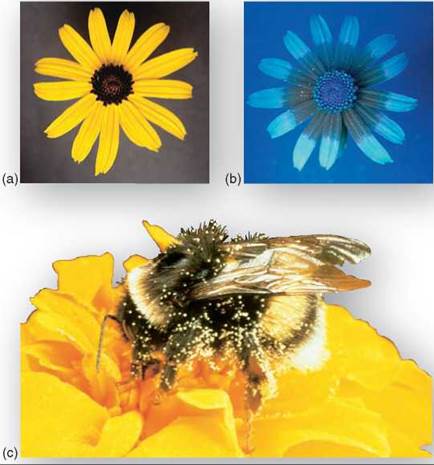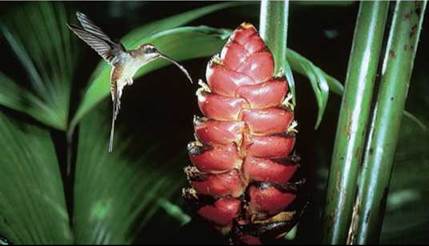THE LIVING WORLD
Unit Seven. Plant Life
32. Evolution of Plants
32.9. Why Are There Different Kinds of Flowers?
If you were to watch insects visiting flowers, you would quickly discover that the visits are not random. Instead, certain insects are attracted by particular flowers. Insects recognize a particular color pattern and odor and search for flowers that are similar. Insects and plants have coevolved (see chapters 34 and 35) so that certain insects specialize in visiting particular kinds of flowers. As a result, a particular insect carries pollen from one individual flower to another of the same species. It is this keying to particular species that makes insect pollination so effective.
Of all insect pollinators, the most numerous are bees. Bees evolved soon after flowering plants, some 125 million years ago. Today there are over 20,000 species. Bees locate sources of nectar largely by odor at first (that is why flowers smell sweet) and then focus in on the flower’s color and shape. Bee-pollinated flowers are usually yellow or blue, like the yellow flower in figure 32.15a. They frequently have guiding stripes or lines of dots to indicate the position in the flower of the nectar, usually in the throat of the flower, but these markings may not always be visible to the human eye. For example, the yellow flower in figure 32.15a looks very different through an ultraviolet filter in figure 32.15b. The UV rays show a dark area in the middle of the flower, where the nectar is located. Why have hidden signals? Because they are not hidden from bees that can detect UV rays. While inside the flower, the bee becomes coated with pollen, as in figure 32.15c. When the bee leaves this flower and visits another, it takes the pollen along for the ride, pollinating a neighboring flower.

Figure 32.15. How a bee sees a flower.
(a) A yellow flower photographed in normal light and (b) with a filter that selectively transmits ultraviolet light. To a bee, this flower appears as if it has a conspicuous central bull's-eye. (c) When inside the flower, the bee becomes covered in pollen, which it takes to a neighboring flower.
Many other insects pollinate flowers. Butterflies tend to visit flowers of plants like phlox that have “landing platforms” on which they can perch. These flowers typically have long, slender floral tubes filled with nectar that a butterfly can reach by uncoiling its long proboscis (a hoselike tube extending out from the mouth). Moths, which visit flowers at night, are attracted to white or very pale-colored flowers, often heavily scented, that are easy to locate in dim light. Flowers pollinated by flies, such as members of the milkweed family, are usually brownish in color and foul smelling.
Red flowers, interestingly, are not typically visited by insects, most of which cannot “see” red as a distinct color. Who pollinates these flowers? Hummingbirds and sunbirds (figure 32.16)! To these birds, red is a very conspicuous color, just as it is to us. Birds do not have a well-developed sense of smell, and do not orient to odor, which is why red flowers often do not have a strong smell.

Figure 32.16. Red flowers are pollinated by hummingbirds.
This long-tailed hermit hummingbird is extracting nectar from the red flowers of Heliconia imbricata in the forests of Costa Rica. Note the pollen on the bird's beak.
Some angiosperms have reverted to the wind pollination practiced by their ancestors, notably oaks, birches, and, most important, the grasses. The flowers of these plants are small, greenish, and odorless. Other angiosperm species are aquatic, and while some have developed specialized pollination systems where the pollen is transported underwater or floats from one plant to another, most aquatic angiosperms are either wind pollinated or insect pollinated like their terrestrial ancestors. Their flowers extend up above the surface of the water.
Key Learning Outcome 32.9. Flowers can be viewed as pollinator-attracting devices, with different kinds of pollinators attracted to different kinds of flowers.